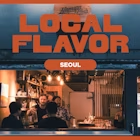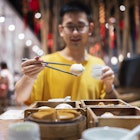
Zen retreat: a beginner's guide to Korean temple stays

Oct 21, 2014 • 6 min read

Flowers blooming at Magok-sa Temple. Image by Megan Eaves / Lonely Planet
3am. Stars hover over a misty mountain temple. A gong sounds, rousing you from sleep on a thin floormat.
Your feet crunch in the dark, making their way up to the daeungjeon, the main hall. Shoes come off at the door, and, sock-footed, you choose a pillow, clasping your hands together and kneeling, then bowing your forehead to the floor, standing again and bowing again. Outside, crickets and a splashing brook provide a dawn soundtrack. This is a typical morning at a Korean temple stay.

Buddhism was brought to Korea from China and has been practiced here for 1,700 years. Generally, Korean temples adhere to a meditative form of Buddhism called Seon, better known by its Japanese name: Zen. There are dozens of working Buddhist temples around South Korea today, many of which are part of Templestay (templestay.com), an official program that allows visitors to participate in monastic Buddhist life for short stays.
As most Korean temples are located in the mountains surrounded by peaceful greenery, participating in a temple stay is a wonderful way to escape the country’s urban buzz while rejuvenating soul and body. But fear not, you don’t need to be a zen master to do a temple stay: programs are geared to giving participants a thorough introduction to life in a Buddhist temple. People of all backgrounds are welcomed, and options vary from rigorous spiritual and physical challenges to relaxed programs focused on cooking or meditating.
Temple stay basics

Most official Templestay programs last for one or two days, including an overnight. During this time, participants are completely immersed in the monastic lifestyle, right down to the simple comfy cotton uniform you’re expected to wear throughout the stay. Each temple’s program differs slightly, but most incorporate meditation and prostrations (bowing to the Buddha), though some are more rigorously spiritual than others. Participants are usually offered a choice of activities designed to harness spiritual concentration. Participants are also expected to eat temple food and learn the basics of etiquette around monks and temple staff. Many temple stays are conducted in English or through interpreters, and you'll find often the staff and monks at Korean temples speak excellent English. Not every temple is open to international participants, though, so its best to enquire with the specific temple or the Templestay organisation before booking.
Temple stay activities

Each temple will design its own program and activities based on its unique location and particular spiritual focus. But there are a few activities that almost every temple stay takes in:
Meditation
One of the true joys of a temple stay is the chance to clear your mind and spend time simply being. Meditation activites are often seated, sometimes in the temple grounds or outside at a beautiful natural spot. A monk will instruct you on the proper posture to clear your mind.
Prostrations
Every temple stay includes the act of prostrating, or bowing. You’ll learn the precise etiquette and actions for bowing before you attend any prayer services. More rigorous temples may require participants to make 1,080 prostrations a day, while more casual temples may require fewer bows.

Tea ceremony
Many temple stay programs include a traditional tea ceremony, during which a monk teaches you the formal rites for making tea. Oftentimes, the tea ceremony also incorporates a dialogue with the monk, where you are free to ask and answer questions.
Other activities can include outdoor walks or guided meditations, foraging and cooking classes and learning to make temple lanterns or strings of beads.
Sleeping at the temple

Accommodations at Korean temples are simple, clean and usually fairly modern. Men and women are usually bunked separately, often with 2-3 people in a basic room. Floormats, blankets and pillows are provided for sleeping on the floor, and rooms have simple amenities like lights and fans for hot nights. Monks generally sleep and rise with the sun, which results in an early night and very early pre-dawn morning.
Upon arrival, you’ll be assigned a room and given a comfortable cotton uniform, which you’ll wear throughout the stay. Shoes are always removed before entering any interior space in the temple, and you’ll be expected to clean up your room before you depart.
Toilets and bathrooms in the temple are communal (your bedroom won’t be ensuite), but they are generally clean and well-kept, with modern showering facilities, not unlike what you’d find in a decent hostel.
Buddhist food

Buddhist food is a rich vegetarian cuisine that is among the most diverse and interesting on offer in Korea. Most Korean temples are actively involved in the production of their food; some even forage for food and grow local vegetables, meaning what you eat during a temple stay is extremely healthy and extremely delicious. It is expected you’ll take only what you need and always finish everything off from your bowl, down to the last grain of rice, but it’s perfectly acceptable to go for multiple rounds to fill up. The idea is not to go hungry, but rather simply not to waste. And after the meal, each participant is expected to clean their own bowl and chopsticks.
Tips for temple stay first-timers

Bring comfy socks and slip-on shoes. Having to re-tie your shoelaces each time you enter and exit a room is exhausting.
Flip flops or shower shoes are useful for using communal showers.
Bug spray can come in handy, especially during summer months.
Smoking, sex (even for married couples), drinking and loud behaviour are off-limits in most Korean temples. Participants are expected to act in a manner that respects the culture and spirituality of the temple.
Some temple stays are also open to kids and families, but not all are, so if you’re planning to travel with your family, enquire with the temple in advance.
Most temples are located high in the mountains, which can be quite cool even in summer. It’s sensible to bring along extra layers, just in case.
Where to try a Korean temple stay

More than 100 temples around Korea offer official Templestay programs, many of which are conducted in English and welcome foreign participants. There’s a wide variety of choice, ranging from really remote temples to quick getaways near Seoul designed for weekend rejuvenation.
Guin-sa offers temple stay programs in the heart of Sobaeksan National Park.
Jikji-sa is a refined ancient temple (its oldest structure dates to 1602) with some incredible Buddhist art on display inside a museum onsite.
Golgul-sa offers a traditional temple stay with a unique twist: here you can also learn the traditional Korean martial art sunmudo during your stay.
Geumsun-sa (geumsunsa.org) offers traditional temple stay programs that also take in trekking on Mt Bukhan, and is situated along public transportation from Seoul.
Magok-sa (magoksa.or.kr) is a beautifully isolated mountain temple offering traditional temple stays that include dawn meditative walks along the riverside and an immersive experience in learning about monastic life.
The official Templestay website (eng.templestay.com) has a wealth of information on every temple and offers the chance to book online. Alternately, they have an information centre, located across from Jogye Temple in Seoul, where you can pick up leaflets, ask questions or book a stay.
Megan Eaves is Lonely Planet's North Asia Destination Editor. She travelled to Korea with support from the Korea Tourism Organisation (visitkorea.or.kr; +44 20 7321 2535). Lonely Planet contributors do not accept freebies in exchange for positive coverage.
Explore related stories




 ActivitiesLonely Planet's guide to visiting a Korean bathhouse for the first time
ActivitiesLonely Planet's guide to visiting a Korean bathhouse for the first timeJun 19, 2024 • 8 min read

 Food10 of the world’s best foodie destinations (and what to eat when you get there)
Food10 of the world’s best foodie destinations (and what to eat when you get there)Mar 1, 2024 • 12 min read



